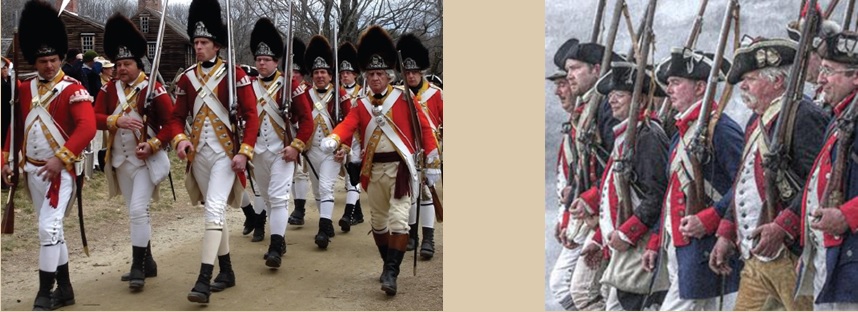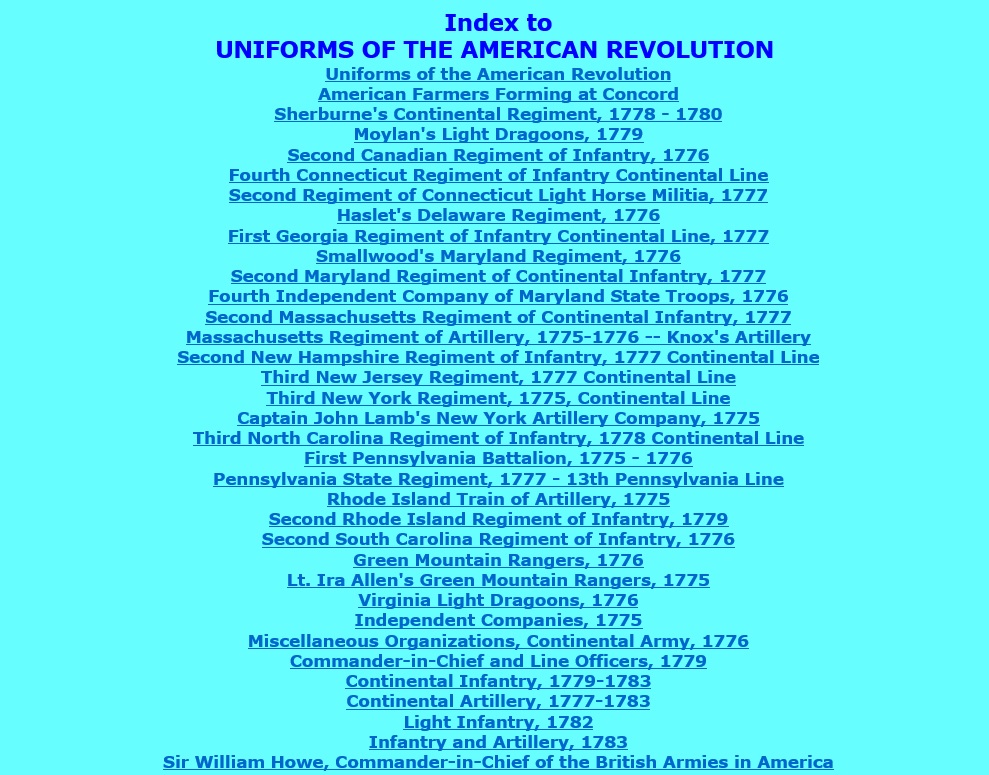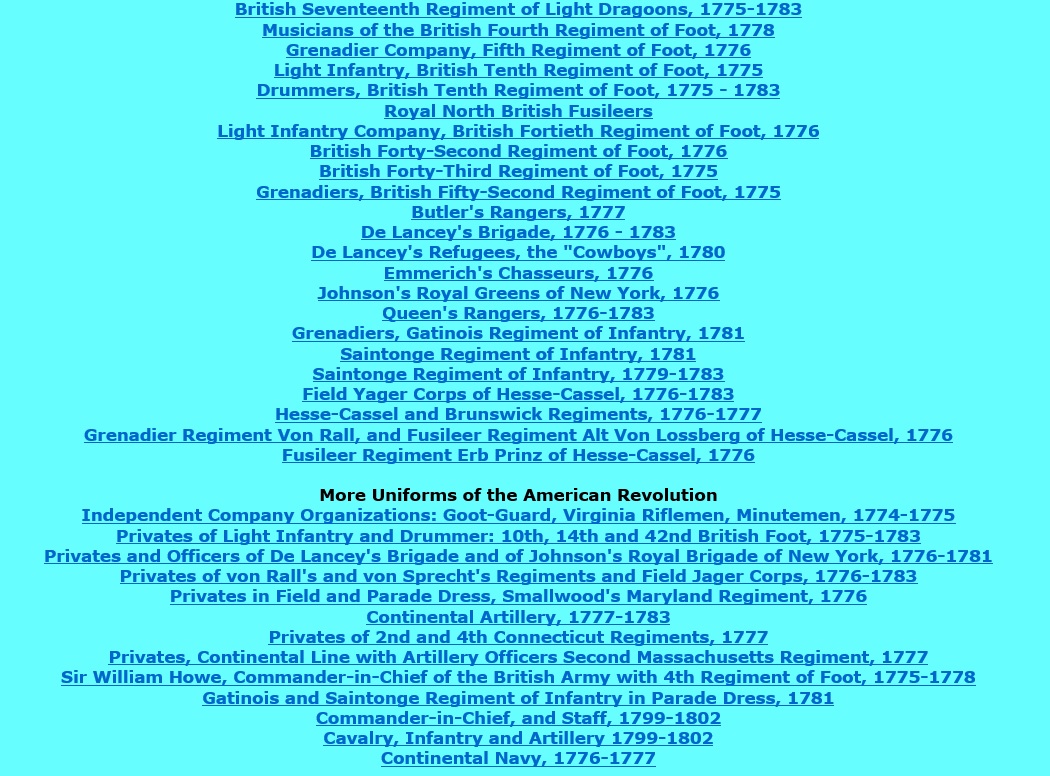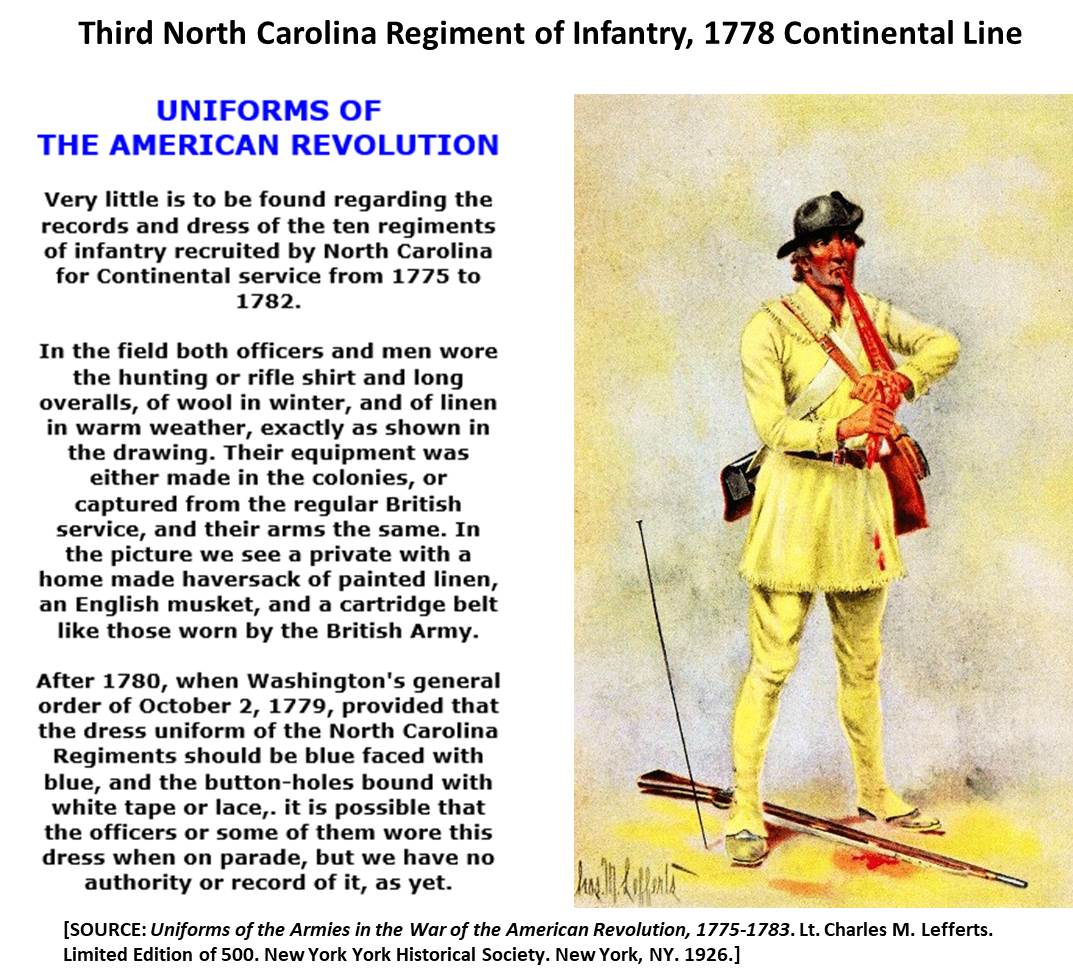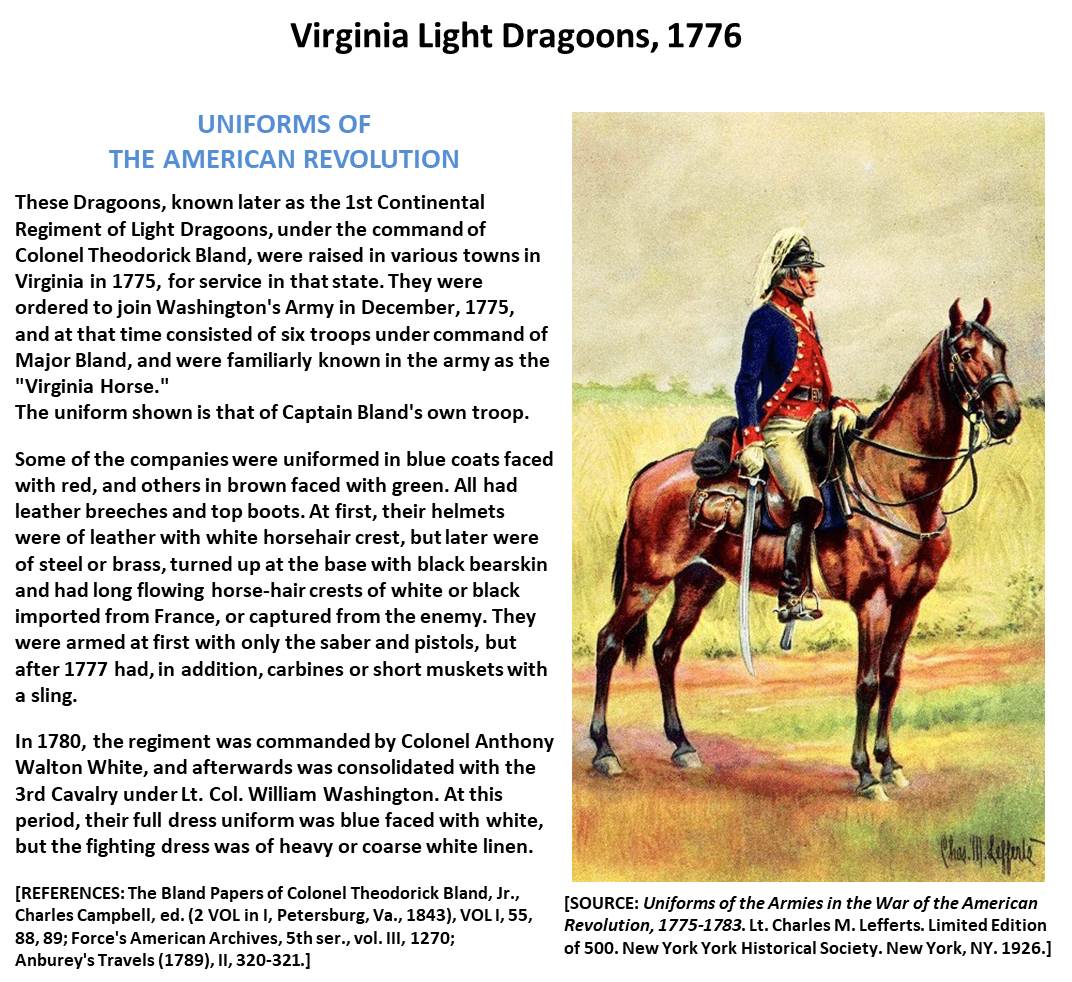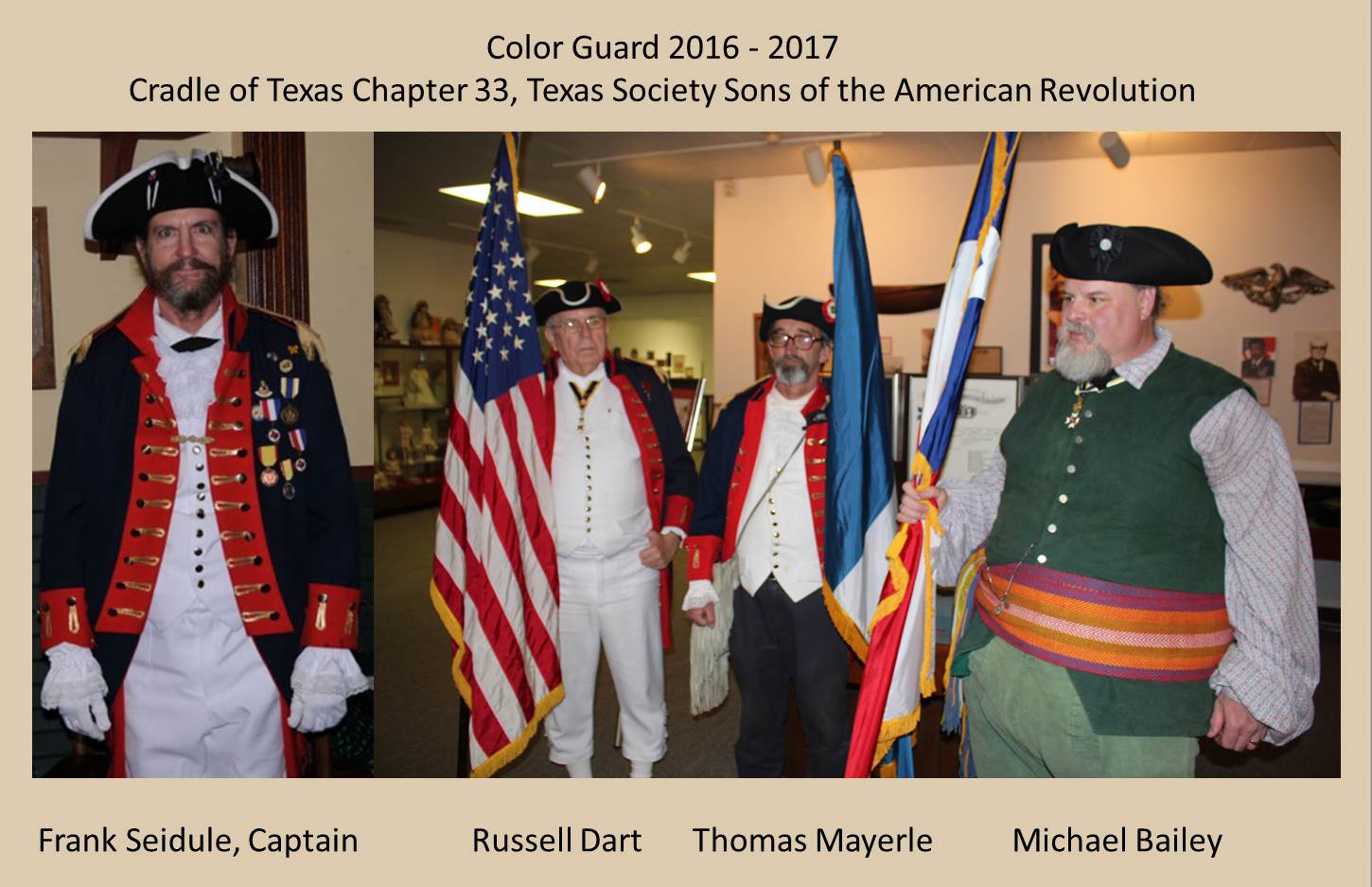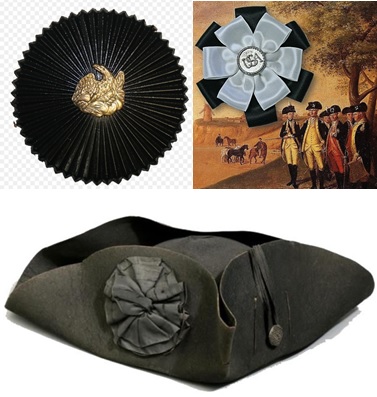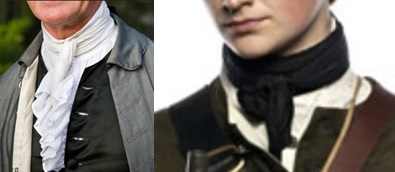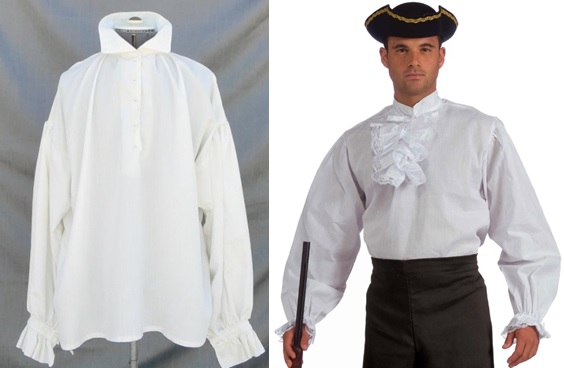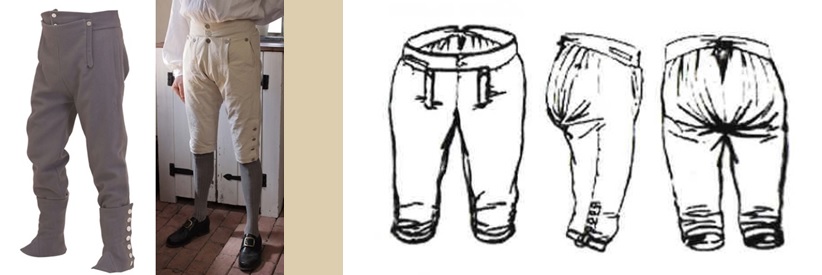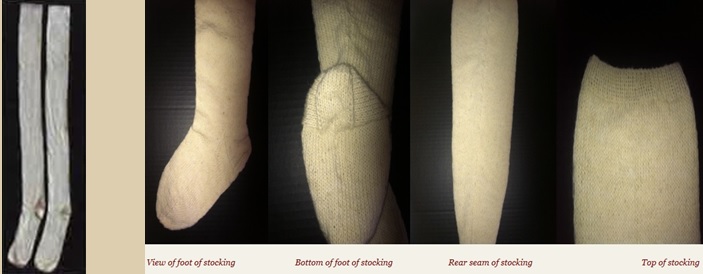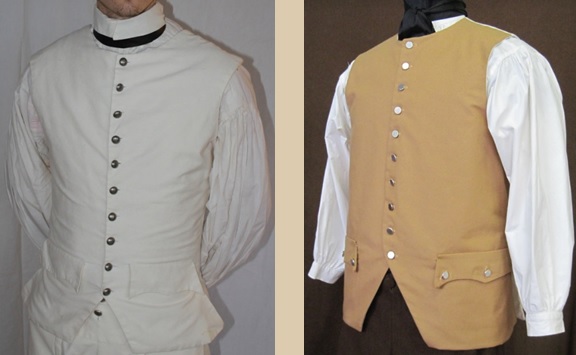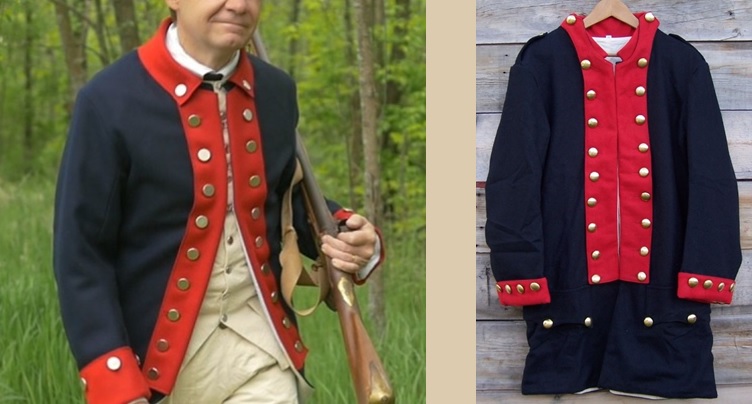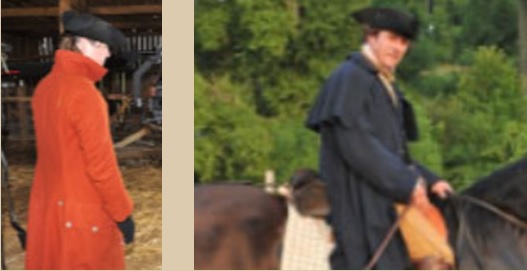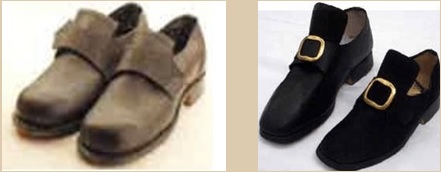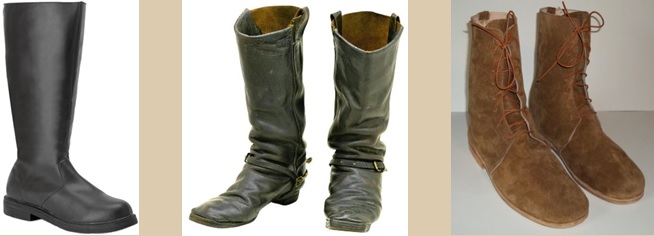Information is provided below to Compatriots about the varied uniforms and period clothing worn by patriots in the American Revolutionary War. Today, Compatriots serving in the chapter Color Guard may wear replicas of Continental Army and Colonial Militia uniforms including colonial period clothing. Some Compatriots, when they appear at current patriotic events and reenactments, may want to wear replicas of the uniform or clothes that their patriot ancestor wore. In either case information is provided below to help one determine what constitutes an appropriate American Revolutionary War uniform, their components and accessories, and how, where and at what cost to acquire them.
What Patriots Wore During the American Revolutionary War
What a patriot soldier wore depended on:
• when they served
– dress evolved from regular clothes to actual uniforms during the 8 years of the revolution
• where they served
– continental uniform coat facing and trim color could vary by state regiment
• how they served
– uniforms and/or clothing differed among soldiers of continental army, state militia, foot soldier,
musketeer or rifleman, horse soldier, artillery, or navy
When the Revolutionary War began in 1775 with hostilities in Lexington and Concord, MA there were no American uniforms because there was no national or American army. In the beginning of the Revolution there was no established American government or American money to purchase uniforms with since the British Crown ruled the colonies. Therefore, the first patriot soldiers of the state or colonial militias wore their everyday clothes (figure 1).
Figure 1. Militiamen of the battles of Lexington and Concord MA
Later during the war, uniforms differed most dramatically between the two basic types of American soldiers: those who served in the Continental Line and wore uniforms similar in design to those of the British soldiers; and those who served in the various colonial and/or state militias who wore their everyday clothes. Riflemen (or sharpshooters) and frontiersmen typically wore hunting shirts whether they served in the main army or in the militia (figure 2).
Colonial Army Uniform Colonial Militia Uniform
Figure 2. American Revolutionary War Uniforms in 1775
The Continental Line, or Continental Army, was the first free-standing army sanctioned by the Continental Congress under the command of General George Washington in June, 1775. It was the precursor of todays’ US Army. Each colony was called upon to contribute a certain number of regiments according to their population. Many soldiers in the Continental Army were eventually issued uniforms. Over the course of the war (1775-1783), a Continental Line soldier’s particular uniform and its trim depended on many factors: the actual availability of uniforms themselves or material fabrics for uniform construction; the particular regiment of the army where the patriot served; the capacity in which the soldier served (foot, artillery, rifleman, horse, navy), his rank, where he was located (colony, state, regiment) and during which period of the war he served (figure 3).
American officer uniform American artillery uniform
Figure 3. Some differences in American Revolutionary War uniforms
 Soldiers serving in the colonial and state militias were citizen soldiers – some were minutemen who could be called into action on short notice. In battle the militia often wore work clothes or the clothes of their trade – farmers, businessmen, craftsmen, hunters, etc., and sometimes individual state militias established their own uniforms. Hunting shirts were often worn especially by militia riflemen or sharpshooters (figure 4).
Soldiers serving in the colonial and state militias were citizen soldiers – some were minutemen who could be called into action on short notice. In battle the militia often wore work clothes or the clothes of their trade – farmers, businessmen, craftsmen, hunters, etc., and sometimes individual state militias established their own uniforms. Hunting shirts were often worn especially by militia riflemen or sharpshooters (figure 4).
Figure 4. American militia sharpshooters and
riflemen wore hunting shirts
Friend or Foe? – The Importance of Uniform Color
When muskets began firing between American and British forces, vision on the battlefield was quickly deteriorated by smoke making it difficult to determine friend from foe. Since the British Army traditionally wore predominately red uniforms (figure 5a), the American Continental Army chose uniforms that were predominately blue in color (figure 5b) to help provide some contrast.
a) British Regular Army (Grenadiers) b) American Continental Line
Figure 5. Contrast in uniform color helped determine friend from foe during battle
Find the Uniform Worn by Your Patriot
The following information on patriot uniforms is from the Society of the Sons of the Revolution in the State of California website. This Society was founded on May 15, 1893 in Los Angeles, California. In Figure 6, their website provides an index to over 70 links to American state/colonial and continental line regimental uniforms including some British ones. Each link provides descriptions of the uniform and references. If you know where your patriot served, and his unit is in the index, then maybe you can find his uniform.
Figure 6. Index to Uniforms of the American Revolution
Clicking on the following link will take you to the live index page on the Society of the Sons of the Revolution in the State of California website depicted in figure 6 above where you can then click on any entry in the index to search for your patriot’s regiment and uniform description.
http://www.srcalifornia.com/uniforms/uindex.htm
Figure 7 provides a first example of the type of information found in the index, Third North Carolina Regiment of Infantry, 1778 Continental Line:
Figure 7. Third North Carolina Regiment of Infantry, 1778 Continental Line
Figure 8 provides a second example of the type of information found in the index, the Virginia Light Dragoons, 1776:
Figure 8. The Virginia Light Dragoons, 1776
Uniforms Worn by Color Guards
SAR color guard units wear American Revolutionary War and Militia uniforms. According to the TXSSAR Color Guard Handbook, a Color Guard unit optimally consists of four men:
• two Color Bearers who carry the American Flag and the State (or SAR) Flag
• two Musketeers or Riflemen who escort the Color Bearers
This is not a hard and fast rule, however, and units can consist of as few as three men or have more than four. Also, color guard units may consist entirely of men dressed in the familiar tricorn hat, blue coat and knee breeches or fall-front trousers identified with the soldiers of the regular Continental Army, or they may consist entirely of men dressed as a militia unit wearing their everyday clothes of the late 1700s, or they may consist of a mix of the two types of uniforms (Continental and Militia). Our Cradle of Texas Color Guard unit recently consisted of three men dressed as Continental Line soldiers and one dressed as a Militiaman (figure 9):
Figure 9. Recent Cradle of Texas Chapter SAR Color Guard (Tom Mayerle died in 2017)
On the left in Figure 9, Color Guard Captain Frank Seidule wears a Continental Army uniform consisting of a tricorn hat, black neck cloth, blue coat with red facing, cuffs and collar, white ruffled shirt, white waistcoat, white fall front knee breeches and white gloves. On the right, Michael Bailey wears Militia uniform consisting of a tricorn hat, checkered shirt with black neck covering, green waistcoat and green trousers. Note: Michael’s outer garment, typically a hunting shirt, is not being worn in this photo.
Components of Patriot Uniforms
The regimental uniform of the continental line army
The basic Continental Army uniform consists of the following:
• A tricorn hat;
• A blue coat with either a buff, red or white facing and trim;
• White shirt and waistcoat;
• White or buff knee britches or fall-front trousers;
• Buckle shoes;
• A pair of white gloves.
Headgear: Most regular hats during the American Revolution can be described as a “cocked hat” such as the tricorn turned up on three sides (figure 10 a) or an “un-cocked hat” such as a round hat (figure 10 b).
a) Tricorn hat b) Round hat
Figure 10. Basic headgear
The majority of hats were made out of wool felt or beaver fur and dyed black or white, round blocked, and had a liner on the inside made of linen, silk, or similar material. Civilian hats ranged from the very simple and cheap to the extravagant – trimmed in gold or silver lace, dressed with a cockade, and sometimes adorned with ostrich feathers. A cockade is a knot of ribbons, or other circular- or oval-shaped symbol of distinctive colors which is usually worn on a hat as a badge of office. In some Patriot militia and minute companies cockades of different colors to designate rank were worn in the hats of officers and non-commissioned officers (figure 11).
Figure 11. Examples of cockades worn on hats
Knit wool caps were often worn in cooler weather, while linen caps might be worn in warm weather. Most men in the 18th century owned both a regular hat and knit cap, and in many cases owned multiple hats and caps. Many different types of headgear were worn including helmets (predominately worn by cavalry units as in Figure 8 above). If wearing a specific unit’s uniform, the correct headwear should be worn. For purposes of the SAR Color Guard, a simple black tricorn will suffice.
Neck Coverings: Neckerchiefs and neck stocks were the 18th century version of the modern necktie. A man needed to wear a neckerchief or neck stock around his neck and over the collar of the shirt to be considered properly dressed by 18th century standards. Neckerchiefs were made of solid or printed silk, linen, or cotton with rolled hemmed edges. They were folded diagonally and tied in a square knot at the neck. Neck stocks were typically white or black and made of linen, cotton, or silk (figure 12). Unlike neckerchiefs, neck stocks were fastened around the neck with ties or a buckle. Military neck stocks of the American Revolution were also made of leather or horsehair.
Figure 12. Examples of neck coverings
Shirts: A man’s shirt during the 18th century was considered his underwear. In public, a shirt was rarely worn without a waistcoat or jacket over it. A man dressed in public only wearing a shirt without a waistcoat or jacket over it was considered “naked” by 18th century standards. The length of shirts tended to be long, about mid-thigh to just below the knee in length, because a shirt was not just worn in the day but also doubled as a nightgown. Additionally shirts were made long because for many men a shirt was their only form of underwear. Shirts during the time of the American Revolution were made of a variety of different fabrics and were made full and wide for maximum comfort and ease of movement. The majority of shirts were made of plain, checked, or striped fabrics. Shirts made of linen, cotton, light-weight flannel, and fabric blends were the most prevalent in New England. Men’s shirts of the 18th century were all cut in same manner from rectangles and squares, the only difference between the shirt of a laborer and that of gentleman was the quality of the fabric and attention to detail of how it was constructed. A shirt made for a gentleman would have been constructed of fine cotton or linen bleached white, ruffles may have been added, and the quality of the craftsmanship and hand stitching would have been top-notch and surpassed that of a common working class shirt (figure 13). Shirts during the American Revolution tended to have
Figure 13. Examples of shirts
narrow wristbands (cuffs) closed by wrist buttons (cuff links). Collars varied in height but tended to not be as high as later 1790s or early 19th century shirts when high collars were all the rage. Shirts were pullover style and only closed at the collar and did not have plackets or buttons down fronts like shirts from later time periods. Shirts were closed with buttons, linen or thread ties, or combination of buttons and linen or thread loops. Buttons were made from a variety of materials and tended to be on the smaller side around 1/2″ or 7/16″ in diameter. Common types of buttons used on shirts tended to be made of thread, horn, cloth covered, metal, or leather. Shirts always were one of the first clothing items to wear out and fall apart during active military service especially in the warmer months.
Knee Breeches and Trousers: The Patriots who went off to war in 1775 wore either knee breeches or trousers with a “fall front” closure, called a “full fall” or “half fall,” as opposed to the earlier older style “fly front” button closure. The “fall front” eliminated fly buttons and created a smooth fit across the front of the breeches that when wearing a full suite of clothes eliminated the visibility of buttons and created the silhouette of smooth lines. The 1770s was a transitional period in regards to where the waistband sat, and in 1775 it either was placed to ride on the hip bones or just above the natural waist. Breeches worn by New Englanders commonly were made of leather, wool, linen, velvet, silk, or fabric blends. Leather breeches where quite common among New Englanders and made of dressed and sometimes dyed buckskin, elk, or sheepskin. Breeches went down below the kneecap but no lower than the top of the shinbone, and were closed at the knee with ties or buttons. The knee-band was closed with a buckle, button, or drawstring pulled through the casing of the knee-band and was tied off. Breeches were tailored to closely fit the body and were form-fitting. Trousers were a popular garment among the working class and sailors, and typically in length went down to just below the calf or above the ankle. Commonly trousers were made of linen, wool, cotton, or fabric blends. Trousers were usually tailored looser and baggier than that of the fit of breeches (figure 14). Trousers were quite common with American militiamen and soldiers during the American Revolution especially during the warmer months. Common buttons on both breeches and trousers were cloth covered, thread wrapped, metal, leather, or horn. The backs of the waistbands on breeches and trousers were adjustable with a gusset and lacing (figure 15).
Figure 14. Fall-front trousers (left); Figure 15. Knee breeches have adjustable backs
knee breeches (right
Stockings and Socks: Stockings, or hose, were worn with both knee breeches and trousers (figure 16). Socks were worn with trousers. Stockings came up over the knee and were secured with cloth or leather garters that either tied or buckled. Stockings were primarily knit and made of wool, cotton, linen, silk, or fabric blends. For the most part stockings were knit on machines, although still many were knit by hand. Machine knit stockings were manufactured in two flat pieces, then in the factory hand sewn together up the back creating a “back seam” (figure 17).
Figure 16. Stockings Figure 17. Different views of knit stockings
Stockings made of thread, or cut and sewn cloth were common among the poor and working class. Socks were shorter than stockings and did not go over the knee. Socks were made from the same materials as stockings with the exception of finer materials such as silk, and the process for making socks was different but very similar. Stockings and socks were available in a plethora of different solid colors, but bleached and shades of white were the most common.
Waistcoats: A waistcoat, the 18th century equivalent to a modern vest, was the part of a man’s clothing worn over the shirt and under the coat or jacket. Waistcoats were made with and without sleeves. A waistcoat without sleeves was the most common style worn with a full suite of clothing, although in colder weather sleeved waistcoats were favored. It was considered a social taboo in the 18th century for men to go in public showing their shirt sleeves. Men would almost never be caught in public just wearing a shirt and an un-sleeved waistcoat with no coat or jacket worn over. Waistcoats were either single or double breasted, and were constructed of wool, linen, velvet, silk, or fabric blends. In a suite of clothing typically the buttons on a waistcoat matched that of the coat, and sometimes the fabric and color of the waistcoat were of a contrasting color, design, and/or texture to the coat and breeches. Common buttons on waistcoats were cloth covered, thread wrapped, metal, leather, or horn. On the eve of the American Revolution waistcoats ranged in length from the older styled mid-thigh length of the 1750s-60s to the more common shorter skirted style just below hip level of the 1770s. Waistcoats featured a button front, and the neckline was high and rounded. Typically waistcoats had pockets which were located at waist level. Waistcoats were tailored to closely fit the body and were form-fitting (figure 18).
Figure 18. White and buff colored waistcoats
Waistcoats were tailored to cover the waistband and the edges of the “fall front” of the breeches. In cold weather under-waistcoats were worn. These were waistcoats made primarily of light-weight warm wool, and worn under the standard waistcoat, or sometimes under the shirt. The pattern and construction of under-waistcoats differed from that of standard waistcoats and tended to be shorter in length. Under-waistcoats were typically closed down the front with cloth ties or lacing through hand worked grommets opposed to buttons and buttonholes.
Coats and Jackets: Coats and jackets were the types of outer garments worn by men in the 18th century. Coats and jackets were worn over the shirt and waistcoat. Typically, coats were constructed of wool, linen, velvet, silk, or fabric blends. Jackets were considered a working class garment and were commonly made of wool, linen, or fabric blends. Common types of buttons on both coats and jackets were cloth covered, thread wrapped, metal, leather, or horn. Both coats and jackets were tailored to closely fit the body and were form-fitting. The length of coats varied from mid-thigh to knee length. During the 1770s there were two types of coats men wore. The frock coat was worn by men of all social classes. The dress coat was a formal garment constructed of the finest materials, finely tailored, and was often reserved for the social elite. Both types of coats had cuffs, and depending upon the style may or may not have had a collar. Typically a frock coat had a single or double breasted button front, the neckline was high and rounded, and had functioning pockets. On the other hand, dress coats typically were not cut to have a functioning button front. Instead, they had faux buttonholes and buttons purely for decoration. Many dress coats fastened down the front with hooks and eyes, or had a couple functional buttonholes at the top of the coat. The neckline of dress coats was high, and typically the pockets on dress coats were not functional (figure 19).
Figure 19. Dress (left) and frock (right) regimental coats
Jackets are best described as a waistcoat with sleeves or a shortened version of a coat. Jackets had a single or double breasted button front, the neckline was high and rounded, and had functioning pockets. Depending upon the style, jackets may or may not have had a collar and cuffs. There were different styles of jackets in the 1770s; one of the more common styles among the working class was the “sailor jacket,” which was the style of jacket worn by many mariners during the time period.
Greatcoats or Surtouts: The greatcoat/surtout was a stout wool overcoat worn by men over their clothing in cold weather. Typically reaching to below the knees, greatcoats/surtouts had a collar, a cape (or capes) to shed the rain, large cuffs, and a slit in the back to allow for riding a horse. Greatcoats/surtouts were often closed by a button front, tabs that went across the opening and buttoned, or tied shut with cloth ties (figure 20).
Figure 20. Surtcoats or greatcoats
Shoes and Boots: At the time of the American Revolution, men’s shoes were styled as low quarter, rough or smooth side out, black leather shoes with buckles or ties (laces). Most shoes of this time period were straight lasted to fit either the right or left foot (figure 21).
Figure 21. Shoes
Lace-up, ankle-high half-boots were also worn; these were favored by gentlemen hunters, horsemen, and military officers (figure 22).
Figure 22. Different styles of boots
The shoe industry was thriving on the eve of the American Revolution in the Thirteen Colonies and shoes could have been bought readymade “off the rack” or custom made from local shoemakers. Shoes were also imported from England. Shoes were butt stitched together, made from vegetable tanned leather, and typically had rounded toes. Sometimes they had pointed or square toes. For men engaged in prolonged and hard military service shoes wore out rather quickly. Obtaining period, buckled shoes can be expensive. As such, color guardsmen may want to purchase buckles that can slide over modern shoes and give the appearance of buckle shoes. Another option is to hide the modern shoe by: 1) wearing gaiters that cover the lower leg and tops of the shoes; or 2) wearing trousers as part of the uniform that have facings that extend over the face of the shoe and are secured using either elastic or leather straps below the shoe. Both the comfort and safety of the color guardsmen are important considerations when walking or marching in a parade since period correct footwear can cause blisters or may not provide appropriate traction on modern surfaces.
The Uniform of State or Colonial Militiamen
The basic Militia uniform consists of the following:
• A hat – either tricorn or round;
• A hunting shirt;
• A white or checkered shirt;
• Long britches or fall-front trousers;
• Shoes (need buckles only if the long pant legs do not cover the buckle area).
Hunting Shirt: The hunting shirt worn by American forces during the American Revolution was a backcountry garment made of linen, cotton or wool which originated on the American frontier in the years prior to the American Revolution. Hunting shirts were not worn by the New England patriots who fought at Lexington and Concord, Bunker Hill, and the Siege of Boston. The hunting shirts used by the Virginia regiments of 1775 were made of osnaburg and some had different finishing details to designate rank and regiment. Osnaburg is a durable, strong, lightweight, coarsely woven cotton vintage style fabric that can be dyed, painted, or printed. The hunting shirts used by the 2nd Virginia Regiment in 1775 were dyed purple. The orderly book of the 6th Virginia Regiment provides additional details: “…a hunting shirt well-made and short to come below the waistband of the breeches…” and were to be “…cuffed and caped with red. The Sargent’s to be only cuffed with red. The Drummers and fifers to be white and cuffed with brown and the Corporals shirts to be the same as the men’s but they are to get some red twist…” This level of detail was not repeated in the orderly book for the 2nd Virginia Regiment. By August of 1775, George Washington attempted to outfit the newly formed Continental Army with hunting shirts because they were cheap and effective in both summer and winter, but the hunting shirt was not adopted as a uniform of the Continental Army until 1776. The hunting shirt used later in the war was open in the front, had a single cape, a simple cuff and light fringe as illustrated in the watercolor by Jean-Baptiste Antoine de Verger, a sublieutenant in the Royal Deux-Ponts Regiment that took part in the siege of Yorktown who painted several American soldiers.
Accessories for the Complete Patriot Soldier
MORE TO BE ADDED…..
Steps to Acquire Your Uniform and Accessories
Decide how you want to dress:
as a regimental soldier
as a militiaman
as a color guardsman
Pick the fabric for your uniform
wool
linen
polyester
pros and cons of your choice of fabric
seasonal impacts, cost, authenticity, limitations for certain ceremonial use
Choose your uniform components and colors
regimental uniforms
hat
ruffled shirt
neckwear
waistcoat
regimental coat
cross strap
pants
stockings
shoes
militiaman uniforms
hat
hunting shirt
trousers
shoes
Choose your uniform accessories
Pick a supplier for your uniform and accessories
Costs
Sizing, fittings and delivery




